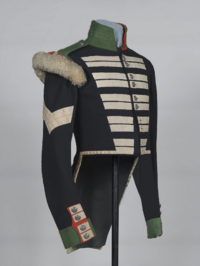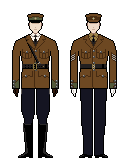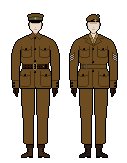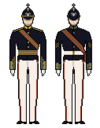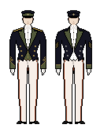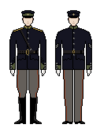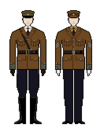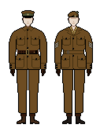Uniforms of the Royal Army (Great Nortend): Difference between revisions
| (36 intermediate revisions by the same user not shown) | |||
| Line 1: | Line 1: | ||
The [[Royal Erbonian Army|Royal Army]] of [[Great Nortend]], formally known as His Majesty's Officers and Men at Arms, are well known for their distinctive uniforms and dress in Great Nortend and beyond. The '''uniforms of the Royal Army''' exist in | The [[Royal Erbonian Army|Royal Army]] of [[Great Nortend]], formally known as His Majesty's Officers and Men at Arms, are well known for their distinctive uniforms and dress in Great Nortend and beyond. The '''uniforms of the Royal Army''' exist in five dress orders, from the most elaborate full dress to the most informal field dress. | ||
==Facing colours== | ==Facing colours== | ||
| Line 31: | Line 31: | ||
* '''White:''' 1st (Royal Narland), 3rd (and Scarlet) (King's Royal Teyshire), 6th (and Yellow) (Queen's Bentshire), 11th (and Blue) (Duke of Towshire's), 24th (and Dark blue) (Duke of Fivewells's), 31st (and Brown) (Chessboards), 32nd (Duke of Morney's), 35th (Duke of Limmes's), 37th (and Dark green) (Poltland), 41st (and Scarlet and Orange) (Suthrepourdeland), 43rd (and Pale green) (Duke of Alvington's) | * '''White:''' 1st (Royal Narland), 3rd (and Scarlet) (King's Royal Teyshire), 6th (and Yellow) (Queen's Bentshire), 11th (and Blue) (Duke of Towshire's), 24th (and Dark blue) (Duke of Fivewells's), 31st (and Brown) (Chessboards), 32nd (Duke of Morney's), 35th (Duke of Limmes's), 37th (and Dark green) (Poltland), 41st (and Scarlet and Orange) (Suthrepourdeland), 43rd (and Pale green) (Duke of Alvington's) | ||
== | ==No. I full dress== | ||
[[File:GNArmyA2.png|left|thumb|200px|Full dress coat of a musician corporal.]][[File:GNArmyA.png|thumbnail|right| | [[File:GNArmyA2.png|left|thumb|200px|Full dress coat of a musician corporal.]][[File:GNArmyA.png|thumbnail|right|Full dress: officers (left), men (right).]]Full dress is the most elaborate and formal day dress available in the Royal Army, being prescribed as day court dress. It is of much of the same pattern as was used in the 19th century, when uniforms were standardised, having changed very little since. Full dress is colloquially known as 'blues and whites' in most infantry regiments, as the main colour for infantry regiments and most service corps is a dark, almost black, blue. Red is used in cavalry regiments, as well as by some foot guards, known therein as 'reds and whites'. Dark grey is used by most service corps, as well as the artificers. | ||
Full dress consists of, in its most general form : | Full dress consists of, in its most general form : | ||
* | * dress coatee | ||
* gaitered-trousers (men) or overalls (officers) | * gaitered-trousers (men) or overalls (officers) | ||
* ankle boots (men) or marching boots (officers) | * ankle boots (men) or marching boots (officers) | ||
* gaiters with ankle boots | |||
* head-dress | * head-dress | ||
* white gloves | * white gloves | ||
The | The tight-fitting coatee is made from worsted wool serge, whipcord or barathea, in the appropriate colour, with facing on the cuffs, collar and tail turnbacks. Buttons are of regimental pattern. Officers wear silver or gold epaulettes on their coats, whereas men wear cloth shoulder straps. Stays are often worn to improve the posture, as well as a leather stock. Swords are worn by officers, as well as a gold and silk or plain red silk sash. SNCOs (serjeants and warranted officers) wear in addition to the belt a shoulder sash of sprung scarlet wool, faced with their regimental facing colour. | ||
Head-dress differs between men and officers, and between regiments. Most ordinary infantry regiments wear the pointed helm, which is a standardised boiled leather pointed helmet, as their full dress head-dress, in gold or silver for officers and brass or white metal for men, though officers of colonel rank and above wear bicornes. Some northern regiments wear what is known as a wool helm, which is a helmet trimmed with lambswool. Cuirassiers wear an open steel helm. Grenadiers wear a traditional grenadier's cap trimmed in black fur. Hunters and artillery regiments wear busbies whilst dragoon regiments wear silver and gold-plated helms. Lancers usually wear czapki. Service corps without any other specialised head-dress wear a leather covered cork helmet, similar in design to the pointed helm but with a ball instead of the point | Head-dress differs between men and officers, and between regiments. Most ordinary infantry regiments wear the pointed helm, which is a standardised boiled leather pointed helmet, as their full dress head-dress, in gold or silver for officers and brass or white metal for men, though officers of colonel rank and above wear bicornes. Some northern regiments wear what is known as a wool helm, which is a helmet trimmed with lambswool. Cuirassiers wear an open steel helm. Grenadiers wear a traditional grenadier's cap trimmed in black fur. Hunters and artillery regiments wear busbies whilst dragoon regiments wear silver and gold-plated helms. Lancers usually wear czapki. Service corps without any other specialised head-dress wear a leather covered cork helmet, similar in design to the pointed helm but with a ball instead of the point | ||
All regular serving soldiers are issued with full dress uniform | All regular serving soldiers are issued with full dress uniform coatees, gloves and boots; however, ceremonial head-dress is only normally issued when needed, except for those with regular ceremonial duties. Officers are required to acquire their own items of dress. | ||
Full dress is regularly worn by the | Full dress is regularly worn by the guard regiments, and army bands. It is also commonly worn at military weddings, funerals, ceremonial occasions, state occasions and public occasions when day court dress or livery is worn, such as courts, and corporate occasions. . | ||
== | ==No. II mess dress== | ||
[[File: | [[File:GNArmyEC.png|thumbnail|right|Mess dress: officers (left), men (right).]]Mess dress is an evening order of dress worn by men and officers at evening messes, state or official dinners, or when court dress is worn. It is issued to SNCOs as a matter of course; however, junior non-commissioned officers and privates will either be required to hire mess dress or wear their full dress uniform instead. | ||
A mess coatee, with tails, is very similar to the full dress coatee but cut as an open front tailcoat similar to a civilian white-tie tailcoat where the two sides linked with buttons and a chain. Regimental facing colours are highly visible in mess dress on both cuffs, collars, inner lining and lapels. White bowed ties are worn, with starched standing collars and starched bosoms. | |||
Waistcoats are worn underneath the mess jacket, of regimental pattern. For officers, they are highly embroidered and frogged, in often gold or silver wire. Tight-fitting overalls are worn by both men and officers with mess dress, along with dress boots. | |||
== | ==No. III undress== | ||
[[File: | [[File:GNArmyB.png|thumbnail|right|Undress: officers (left), men (right).]]Undress originated in the late 19th century as a more practical version of full dress. The dress coatee is replaced by the tunic, which has waist pockets, sometimes breast pockets, and a full skirt. Dark blue trousers (men) or overalls (officers) are worn instead of white ones. For officers, the epaulettes are also replaced with gold or silver braided shoulder boards, and the shoulder strap, belt and waist sash replaced with a Sam Browne belt. For men, the belt is replaced with a plain leather belt, as worn in duty dress. SNCOs continue to wear their sashes over the plain belt. Head-dress is mostly standardised to a peaked forage cap, although some regiments retain their distinctive head-dress. | ||
[[File:GNArmyBC.png|thumbnail|left|Winter undress: officers (left), men (right).]] In winter, a frock coat may be worn instead of the coat, except when on parade. This is double breasted for officers, and single breasted for men. | |||
Undress is the common formal dress of the Royal Army, and is generally worn on Sundays, holidays, official (but not state) occasions and as walking-out dress. All regular serving men are issued with undress items. Officers are required to acquire their own items of dress. It corresponds to civilian informal dress. | |||
== | ==No. IV patrol dress== | ||
[[File: | [[File:GNArmyC.png|thumbnail|right|Patrol dress: officers (left), men (right).]]Patrol dress is the common day-to-day dress for the Royal Army, colloquially known as 'browns'. It was introduced in the early 20th century as a simpler and more practical dress for day-to-day use than compared to either Dress Order I or Dress Order II. | ||
It consists of an open collared khaki-brown serge tunic with pockets, a shirt with detachable collars, white for officers and khaki-tan for men, and a tie in regimental colours for officers and in black wool for men. Khaki-brown trousers (men and officers) or overalls (officers optional) are worn, with service boots and/or field boots. With the tunic, a Sam Browne belt is worn by most officers and a plain leather belt by men. SNCOs may wear their sash around their waist. Head-dress is usually a peaked cap for all ranks and officers, although often No. IVB is ordered, or “bonnet order” when the peaked cap would be impractical. The tunic and belts are also not always worn in bonnet order. In hot weather, the tunic may be removed only or with short trousers and stockings. | |||
Patrol dress is normally worn by all ranks and officers on barracks daily except Sundays (whereon undress would be worn for chapel or church). One set is issued to all militiamen and mustermen, and two sets for regular soldiers. Officers must acquire themselves their own items of dress. Patrol dress may not be worn walking-out by regular soldiers, who must wear undress. | |||
==No. V field dress== | |||
[[File:GNArmyG.png|thumbnail|right|Field dress: officers (left), men (right).]] | |||
Field dress is worn in the field or when patrol dress would be impractical. The most common colour for infantry is plain khaki olive drab, which is suitable for wear in temperate woodland and pasture environments. At its most basic level, soldiers wear a cotton-linen long-sleeved shirt, woollen or cotton drill blouse coat, and woollen trousers, always worn with the service cap, bonnet or helmet. The collar of the shirt is detachable and is always worn. | |||
Brown rough-out boots (polished with black polish) with woollen socks are worn with field dress, and trousers are wrapped with short gaiters around the ankle. In the cold, woollen pullovers are issued to be worn under the coat. When it is hot, the coat may be removed and/or short trousers and stockings may be worn. | |||
==Special orders of dress== | |||
[[File:GNArmyFA.png|thumbnail|right|Ward dress: matrons (left), nurses (right).]]Special dress covers a number of specialised uniform dress orders for different purposes. | |||
==Special | |||
[[File:GNArmyFA.png|thumbnail|right| | |||
'''Ward dress''' | '''Ward dress''' | ||
[[File:GNArmyFB.png|thumbnail|left| | [[File:GNArmyFB.png|thumbnail|left|Ward dress: sisters (left), reserve nurses (right).]]Ward dress is the form of field dress ordered for nurses, sisters and matrons of the Royal Army Nursing Corps when in hospital wards. It consists of in summer a light blue ankle-long gown with white linen apron. In winter, a thick dark grey woollen dress is worn with apron. | ||
Nurses wear a short linen nursing cap, whilst sisters and matrons wear a large | Nurses wear a short linen nursing cap, whilst sisters and matrons wear a large starched linen veil. A shoulder-length tippet cape is worn over the apron and dress, in colours corresponding to rank and/or division. | ||
All nurses, sisters and matrons wear starched detachable collars and cuffs, with matrons and sisters wearing standing collars. | All nurses, sisters and matrons wear starched detachable collars and cuffs, with matrons and sisters wearing standing collars. | ||
'''Legal dress''' | '''Legal dress''' | ||
Legal dress is worn by | Legal court dress is the form of full dress worn by judge-advocates in courts martial. It is the same as full dress except that a judicial gown is worn over the coatee and an advocate's wig replaces the headdress, which is carried. Black breeches and black hose are worn with buckled shoes. No epaulettes are worn by members of the legal services. | ||
==See also== | |||
* [[Uniforms of the Navy Royal (Great Nortend)]] | |||
* [[Royal Army (Great Nortend)]] | |||
==Uniforms== | |||
The uniforms of the Royal Army are split into five orders of dress, ranging from full dress to the varieties of field dress. Each regiment and corps have its own special differences in all orders of dress except field dress. Amongst other distinctions, each such unit has its own farded facings and trims, as well unit cap badges and designs for belt buckle, button and lacing braid. | |||
{{Gallery | |||
| title = Royal Army Orders of Dress | |||
| align =center | |||
| footer = | |||
| style = | |||
|noborder=yes | |||
| state = | |||
| height = 132 | |||
| width = 100 | |||
| captionstyle = | |||
| File:GNArmyA.png | |||
| alt2= | |||
| I. Full dress. | |||
| File:GNArmyEC.png | |||
| alt3= | |||
| II. Mess dress. | |||
| File:GNArmyB.png | |||
| alt5= | |||
| III. Undress. | |||
| File:GNArmyBC.png | |||
| alt5= | |||
| III. a. Winter undress. | |||
| File:GNArmyC.png | |||
| alt4= | |||
| IV. Patrol dress. | |||
| File:GNArmyG.png | |||
| alt5= | |||
| V. Field dress. | |||
}} | |||
===I. Full dress=== | |||
[[File:GNArmyA2.png|right|thumb|200px|Full dress coat of a musician corporal.]]Full dress is the most elaborate and formal order of dress. It is of much of the same pattern as was used in the 19th century, when uniforms were standardised, having changed very little since. Full dress is colloquially known as „whites” in most infantry regiments owing to the white equipment and trousers worn. | |||
Full dress in its most general form consists of :— | |||
* head-dress | |||
* dress coat | |||
* white leather fittings and gloves | |||
* white trousers | |||
* ankle boots and gaiters (men) or marching boots (officers) | |||
The dress coat is made from worsted wool and fits tightly. Officers wear silver or gold epaulettes on their shoulders, whereas men have cloth shoulder straps. Stays are often worn to improve the posture, as well as a leather stock under the collar. Swords are worn by officers, as well as a gold and silk or plain red silk sash. Serjeants and warranted officers also wear a shoulder sash of farded scarlet sprung wool. | |||
Most ordinary infantry regiments wear the spiked leather helm as head-dress, with gilt or silver fittings for officers and brass or white metal for men. Officers of colonel rank and above wear bicorns. Some northern regiments wear the wool helm, a cloth-covered variant trimmed with lambswool. Grenadier regiments wear a similar grenadier's cap, trimmed in black fur. Hunters and artillery regiments wear busbies. Cuirassier regiments wear an open steel helm whilst dragoon regiments wear plumed silver or gilt helms. Lancers usually wear lance helms with a flat top. Service corps without any other specialised head-dress wear the leather helm but with a ball instead of a spike. | |||
===II. Mess dress=== | |||
Mess dress is an evening order of dress worn by men and officers at evening messes, state or official dinners, or when evening court dress is worn. A mess coat is the full dress coat cut open. The cuffs, collars, inner lining and lapels are farded with facing colours. White bowed ties are worn, with starched standing collars and starched shirt bosoms. Waistcoats are worn underneath the mess jacket, of unit pattern. For officers, they are highly embroidered and frogged, in often gold or silver wire. Breeches, stockings and court shoes are worn. | |||
===III. Undress=== | |||
Undress originated in the late 19th century as a more practical version of full dress. The dress coatee is replaced by the tunic, which has waist pockets, sometimes breast pockets, and a full skirt. Dark blue trousers are worn instead of white. For officers, the epaulettes are also replaced with gold or silver braided shoulder cords, and the Sam Browne belt is worn. For men, the belt is replaced with a plain leather belt. Head-dress is mostly standardised to a peaked forage cap. A frock coat may be worn instead of the coat, except when on parade. This is double breasted for officers, and single breasted for men. A great coat may also be worn in winter. | |||
Undress is the common formal dress of the Royal Army, and is commonly worn on Sundays, holidays, official (but not state) occasions and as walking-out dress. All regular men on service are issued with undress items. Officers are required to acquire their own items of dress. | |||
===IV. Patrol dress=== | |||
Patrol dress is the common day-to-day dress for the Royal Army, colloquially known as „browns”. It was introduced in the early 20th century as a simpler and more practical dress for day-to-day use than undress. It consists of an open collared khaki-brown serge tunic with pockets, a white or tan shirt, and a tie in regimental colours for officers and in black wool for men. Khaki-brown trousers are worn, with service boots and/or field boots. With the tunic, a Sam Browne belt is worn by most officers and a plain leather belt by men. Serjeants may wear their sash around their waist. Head-dress is usually a peaked cap for all ranks and officers, although often bonnets are worn when the peaked cap would be impractical. | |||
Patrol dress is normally worn by all ranks and officers on barracks daily except Sundays (when undress would be worn). One set is issued to all militiamen and mustermen, and two sets for regular men. Officers must acquire themselves their own items of dress. Patrol dress is not worn when walking-out. | |||
===V. Field dress=== | |||
Field dress is worn in the field or when patrol dress would be impractical. The most common colour for infantry is plain khaki olive drab, which is suitable for wear in temperate woodland and pasture environments. At its most basic level, soldiers wear a cotton-linen long-sleeved shirt, woollen or cotton drill blouse coat, and woollen trousers, always worn with the service cap, bonnet or helmet. | |||
Brown rough-out boots (polished with black polish) with woollen socks are worn with field dress, and trousers are wrapped with short gaiters around the ankle. In the cold, woollen pullovers are issued to be worn under the coat. When it is hot, the coat may be removed and/or short trousers and stockings may be worn. | |||
{{GNC}} | {{GNC}} | ||
[[Category:Astyrian militaries]] | |||
Latest revision as of 08:54, 2 July 2021
The Royal Army of Great Nortend, formally known as His Majesty's Officers and Men at Arms, are well known for their distinctive uniforms and dress in Great Nortend and beyond. The uniforms of the Royal Army exist in five dress orders, from the most elaborate full dress to the most informal field dress.
Facing colours
Each regiment and corps of the Royal Army has its own facing colour, which is used on fabric for the linings and trim of uniform tunics, coats and head-dress. Some regiments have two or even three facing colours, resulting usually in a striped pattern.
- Scarlet: 2nd (Royal Enley), 3rd (and White) (King's Royal Teyshire), 13th (and Yellow) (Queen Catherine's), 22nd (and Black) (Prince of Leaton's), 41st (and Orange and White) (Queen's Own)
- Crimson: 9th (Norsax Fusiliers), 29th (Red of Gortland), 47th (Duke of Essingford's)
- Red: 15th (Prince of Rhise's Own), 28th (and Orange) (East Aceshire), 49th (Northern Light), Hambrian Guards
- Deep purple: 19th (Harvickshire)
- Maroon: 50th (North Essingford and Plumey)
- Orange: 21st (Margrave of Bine's), 28th (and Red) (East Aceshire)
- Pale orange: 24th (Earl of Roseham's)
- Amber yellow: 7th (Faunslaughter),
- Yellow: 6th (and White) (Queen's Bentshire), 25th (and Black) (Northannering), 38th (with Green) (Prince of Gervis's), King's Own Guards
- Green yellow: 27th (Eamshire)
- Buff: 5th (Cranshire), 26th (Murish Fusiliers)
- Brown: 31st (and White) (Chessboards), 46th (New North Barminstershire)
- Pale green: 17th (Monmorians), 43rd (and White) (Duke of Alvington's)
- Beech green: 18th (Plumwelders), City Guards
- Rhighton green: 36th (King's Rhighton)
- New green: 20th (King's Own Foresters), 42nd (and Light grey) (Igoddal)
- Dark green: 12th (North Larkshire), 37th (and White) (Poltland)
- Egg blue: 10th (Great Walecester), Royal Army Nursing Corps
- Blue: 11th (and White) (Duke of Towshire's), 39th (and Gold) (High Alpiners)
- Royal blue: 17th (Lasmere Marchers), 33rd (Earl of Barminster's), Queen's Own Guards
- Dark blue: 4th (Prince Andrew's South Aceshire), 24th (and White) (Duke of Fivewells's), 45th (Prince of Dunricia's)
- Purple: Royal Army Chaplains' Corps
- Light Grey: 34th (East Gortland), 42nd (and New green) (Igoddal)
- Middle Grey: 14th (Gardolian)
- Black: 8th (Barard), 22nd (and Scarlet) (Prince of Leaton's), 25th (and Yellow) (Northannering)
- White: 1st (Royal Narland), 3rd (and Scarlet) (King's Royal Teyshire), 6th (and Yellow) (Queen's Bentshire), 11th (and Blue) (Duke of Towshire's), 24th (and Dark blue) (Duke of Fivewells's), 31st (and Brown) (Chessboards), 32nd (Duke of Morney's), 35th (Duke of Limmes's), 37th (and Dark green) (Poltland), 41st (and Scarlet and Orange) (Suthrepourdeland), 43rd (and Pale green) (Duke of Alvington's)
No. I full dress
Full dress is the most elaborate and formal day dress available in the Royal Army, being prescribed as day court dress. It is of much of the same pattern as was used in the 19th century, when uniforms were standardised, having changed very little since. Full dress is colloquially known as 'blues and whites' in most infantry regiments, as the main colour for infantry regiments and most service corps is a dark, almost black, blue. Red is used in cavalry regiments, as well as by some foot guards, known therein as 'reds and whites'. Dark grey is used by most service corps, as well as the artificers.
Full dress consists of, in its most general form :
- dress coatee
- gaitered-trousers (men) or overalls (officers)
- ankle boots (men) or marching boots (officers)
- gaiters with ankle boots
- head-dress
- white gloves
The tight-fitting coatee is made from worsted wool serge, whipcord or barathea, in the appropriate colour, with facing on the cuffs, collar and tail turnbacks. Buttons are of regimental pattern. Officers wear silver or gold epaulettes on their coats, whereas men wear cloth shoulder straps. Stays are often worn to improve the posture, as well as a leather stock. Swords are worn by officers, as well as a gold and silk or plain red silk sash. SNCOs (serjeants and warranted officers) wear in addition to the belt a shoulder sash of sprung scarlet wool, faced with their regimental facing colour.
Head-dress differs between men and officers, and between regiments. Most ordinary infantry regiments wear the pointed helm, which is a standardised boiled leather pointed helmet, as their full dress head-dress, in gold or silver for officers and brass or white metal for men, though officers of colonel rank and above wear bicornes. Some northern regiments wear what is known as a wool helm, which is a helmet trimmed with lambswool. Cuirassiers wear an open steel helm. Grenadiers wear a traditional grenadier's cap trimmed in black fur. Hunters and artillery regiments wear busbies whilst dragoon regiments wear silver and gold-plated helms. Lancers usually wear czapki. Service corps without any other specialised head-dress wear a leather covered cork helmet, similar in design to the pointed helm but with a ball instead of the point
All regular serving soldiers are issued with full dress uniform coatees, gloves and boots; however, ceremonial head-dress is only normally issued when needed, except for those with regular ceremonial duties. Officers are required to acquire their own items of dress.
Full dress is regularly worn by the guard regiments, and army bands. It is also commonly worn at military weddings, funerals, ceremonial occasions, state occasions and public occasions when day court dress or livery is worn, such as courts, and corporate occasions. .
No. II mess dress
Mess dress is an evening order of dress worn by men and officers at evening messes, state or official dinners, or when court dress is worn. It is issued to SNCOs as a matter of course; however, junior non-commissioned officers and privates will either be required to hire mess dress or wear their full dress uniform instead.
A mess coatee, with tails, is very similar to the full dress coatee but cut as an open front tailcoat similar to a civilian white-tie tailcoat where the two sides linked with buttons and a chain. Regimental facing colours are highly visible in mess dress on both cuffs, collars, inner lining and lapels. White bowed ties are worn, with starched standing collars and starched bosoms.
Waistcoats are worn underneath the mess jacket, of regimental pattern. For officers, they are highly embroidered and frogged, in often gold or silver wire. Tight-fitting overalls are worn by both men and officers with mess dress, along with dress boots.
No. III undress
Undress originated in the late 19th century as a more practical version of full dress. The dress coatee is replaced by the tunic, which has waist pockets, sometimes breast pockets, and a full skirt. Dark blue trousers (men) or overalls (officers) are worn instead of white ones. For officers, the epaulettes are also replaced with gold or silver braided shoulder boards, and the shoulder strap, belt and waist sash replaced with a Sam Browne belt. For men, the belt is replaced with a plain leather belt, as worn in duty dress. SNCOs continue to wear their sashes over the plain belt. Head-dress is mostly standardised to a peaked forage cap, although some regiments retain their distinctive head-dress.
In winter, a frock coat may be worn instead of the coat, except when on parade. This is double breasted for officers, and single breasted for men.
Undress is the common formal dress of the Royal Army, and is generally worn on Sundays, holidays, official (but not state) occasions and as walking-out dress. All regular serving men are issued with undress items. Officers are required to acquire their own items of dress. It corresponds to civilian informal dress.
No. IV patrol dress
Patrol dress is the common day-to-day dress for the Royal Army, colloquially known as 'browns'. It was introduced in the early 20th century as a simpler and more practical dress for day-to-day use than compared to either Dress Order I or Dress Order II.
It consists of an open collared khaki-brown serge tunic with pockets, a shirt with detachable collars, white for officers and khaki-tan for men, and a tie in regimental colours for officers and in black wool for men. Khaki-brown trousers (men and officers) or overalls (officers optional) are worn, with service boots and/or field boots. With the tunic, a Sam Browne belt is worn by most officers and a plain leather belt by men. SNCOs may wear their sash around their waist. Head-dress is usually a peaked cap for all ranks and officers, although often No. IVB is ordered, or “bonnet order” when the peaked cap would be impractical. The tunic and belts are also not always worn in bonnet order. In hot weather, the tunic may be removed only or with short trousers and stockings.
Patrol dress is normally worn by all ranks and officers on barracks daily except Sundays (whereon undress would be worn for chapel or church). One set is issued to all militiamen and mustermen, and two sets for regular soldiers. Officers must acquire themselves their own items of dress. Patrol dress may not be worn walking-out by regular soldiers, who must wear undress.
No. V field dress
Field dress is worn in the field or when patrol dress would be impractical. The most common colour for infantry is plain khaki olive drab, which is suitable for wear in temperate woodland and pasture environments. At its most basic level, soldiers wear a cotton-linen long-sleeved shirt, woollen or cotton drill blouse coat, and woollen trousers, always worn with the service cap, bonnet or helmet. The collar of the shirt is detachable and is always worn.
Brown rough-out boots (polished with black polish) with woollen socks are worn with field dress, and trousers are wrapped with short gaiters around the ankle. In the cold, woollen pullovers are issued to be worn under the coat. When it is hot, the coat may be removed and/or short trousers and stockings may be worn.
Special orders of dress
Special dress covers a number of specialised uniform dress orders for different purposes.
Ward dress
Ward dress is the form of field dress ordered for nurses, sisters and matrons of the Royal Army Nursing Corps when in hospital wards. It consists of in summer a light blue ankle-long gown with white linen apron. In winter, a thick dark grey woollen dress is worn with apron.
Nurses wear a short linen nursing cap, whilst sisters and matrons wear a large starched linen veil. A shoulder-length tippet cape is worn over the apron and dress, in colours corresponding to rank and/or division.
All nurses, sisters and matrons wear starched detachable collars and cuffs, with matrons and sisters wearing standing collars.
Legal dress Legal court dress is the form of full dress worn by judge-advocates in courts martial. It is the same as full dress except that a judicial gown is worn over the coatee and an advocate's wig replaces the headdress, which is carried. Black breeches and black hose are worn with buckled shoes. No epaulettes are worn by members of the legal services.
See also
Uniforms
The uniforms of the Royal Army are split into five orders of dress, ranging from full dress to the varieties of field dress. Each regiment and corps have its own special differences in all orders of dress except field dress. Amongst other distinctions, each such unit has its own farded facings and trims, as well unit cap badges and designs for belt buckle, button and lacing braid.
I. Full dress
Full dress is the most elaborate and formal order of dress. It is of much of the same pattern as was used in the 19th century, when uniforms were standardised, having changed very little since. Full dress is colloquially known as „whites” in most infantry regiments owing to the white equipment and trousers worn.
Full dress in its most general form consists of :—
- head-dress
- dress coat
- white leather fittings and gloves
- white trousers
- ankle boots and gaiters (men) or marching boots (officers)
The dress coat is made from worsted wool and fits tightly. Officers wear silver or gold epaulettes on their shoulders, whereas men have cloth shoulder straps. Stays are often worn to improve the posture, as well as a leather stock under the collar. Swords are worn by officers, as well as a gold and silk or plain red silk sash. Serjeants and warranted officers also wear a shoulder sash of farded scarlet sprung wool.
Most ordinary infantry regiments wear the spiked leather helm as head-dress, with gilt or silver fittings for officers and brass or white metal for men. Officers of colonel rank and above wear bicorns. Some northern regiments wear the wool helm, a cloth-covered variant trimmed with lambswool. Grenadier regiments wear a similar grenadier's cap, trimmed in black fur. Hunters and artillery regiments wear busbies. Cuirassier regiments wear an open steel helm whilst dragoon regiments wear plumed silver or gilt helms. Lancers usually wear lance helms with a flat top. Service corps without any other specialised head-dress wear the leather helm but with a ball instead of a spike.
II. Mess dress
Mess dress is an evening order of dress worn by men and officers at evening messes, state or official dinners, or when evening court dress is worn. A mess coat is the full dress coat cut open. The cuffs, collars, inner lining and lapels are farded with facing colours. White bowed ties are worn, with starched standing collars and starched shirt bosoms. Waistcoats are worn underneath the mess jacket, of unit pattern. For officers, they are highly embroidered and frogged, in often gold or silver wire. Breeches, stockings and court shoes are worn.
III. Undress
Undress originated in the late 19th century as a more practical version of full dress. The dress coatee is replaced by the tunic, which has waist pockets, sometimes breast pockets, and a full skirt. Dark blue trousers are worn instead of white. For officers, the epaulettes are also replaced with gold or silver braided shoulder cords, and the Sam Browne belt is worn. For men, the belt is replaced with a plain leather belt. Head-dress is mostly standardised to a peaked forage cap. A frock coat may be worn instead of the coat, except when on parade. This is double breasted for officers, and single breasted for men. A great coat may also be worn in winter.
Undress is the common formal dress of the Royal Army, and is commonly worn on Sundays, holidays, official (but not state) occasions and as walking-out dress. All regular men on service are issued with undress items. Officers are required to acquire their own items of dress.
IV. Patrol dress
Patrol dress is the common day-to-day dress for the Royal Army, colloquially known as „browns”. It was introduced in the early 20th century as a simpler and more practical dress for day-to-day use than undress. It consists of an open collared khaki-brown serge tunic with pockets, a white or tan shirt, and a tie in regimental colours for officers and in black wool for men. Khaki-brown trousers are worn, with service boots and/or field boots. With the tunic, a Sam Browne belt is worn by most officers and a plain leather belt by men. Serjeants may wear their sash around their waist. Head-dress is usually a peaked cap for all ranks and officers, although often bonnets are worn when the peaked cap would be impractical.
Patrol dress is normally worn by all ranks and officers on barracks daily except Sundays (when undress would be worn). One set is issued to all militiamen and mustermen, and two sets for regular men. Officers must acquire themselves their own items of dress. Patrol dress is not worn when walking-out.
V. Field dress
Field dress is worn in the field or when patrol dress would be impractical. The most common colour for infantry is plain khaki olive drab, which is suitable for wear in temperate woodland and pasture environments. At its most basic level, soldiers wear a cotton-linen long-sleeved shirt, woollen or cotton drill blouse coat, and woollen trousers, always worn with the service cap, bonnet or helmet.
Brown rough-out boots (polished with black polish) with woollen socks are worn with field dress, and trousers are wrapped with short gaiters around the ankle. In the cold, woollen pullovers are issued to be worn under the coat. When it is hot, the coat may be removed and/or short trousers and stockings may be worn.
This page is written in Erbonian English, which has its own spelling conventions (colour, travelled, centre, realise, instal, sobre, shew, artefact), and some terms that are used in it may be different or absent from other varieties of English. |
